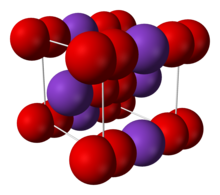Potassium superoxide
 Potassium cations, K+ Superoxide anions, O−2 | |
 | |
| Names | |
|---|---|
| IUPAC name
Potassium superoxide
| |
| Identifiers | |
3D model (JSmol)
|
|
| ChemSpider | |
| ECHA InfoCard | 100.031.574 |
| EC Number |
|
PubChem CID
|
|
| RTECS number |
|
| UN number | 2466 |
CompTox Dashboard (EPA)
|
|
| |
| |
| Properties | |
| KO2 | |
| Molar mass | 71.096 g·mol−1 |
| Appearance | yellow solid |
| Density | 2.14 g/cm3, solid |
| Melting point | 560 °C (1,040 °F; 833 K) (decomposes) |
| Hydrolysis | |
| +3230·10−6 cm3/mol[1] | |
| Structure | |
| Body-centered tetragonal[2][3] | |
| Thermochemistry | |
Std molar
entropy (S⦵298) |
117 J/(mol·K)[4] |
Std enthalpy of
formation (ΔfH⦵298) |
−283 kJ/mol[4] |
| Hazards | |
| Occupational safety and health (OHS/OSH): | |
Main hazards
|
Corrosive, oxidizer, reacts violently with water |
| GHS labelling:[5] | |
 
| |
| Danger | |
| H271, H314 | |
| P210, P220, P221, P260, P264, P280, P283, P301+P330+P331, P303+P361+P353, P304+P340, P305+P351+P338, P306+P360, P310, P321, P363, P370+P378, P371+P380+P375, P405, P501 | |
| NFPA 704 (fire diamond) | |
| Related compounds | |
Other cations
|
|
Except where otherwise noted, data are given for materials in their standard state (at 25 °C [77 °F], 100 kPa).
| |
Potassium superoxide is an inorganic compound with the formula KO2.[6] It is a yellow paramagnetic solid that decomposes in moist air. It is a rare example of a stable salt of the superoxide anion. It is used as a CO2 scrubber, H2O dehumidifier, and O2 generator in rebreathers, spacecraft, submarines, and spacesuits.
Production and reactions
[edit]Potassium superoxide is produced by burning molten potassium in an atmosphere of excess oxygen.[7]
- K + O2 → KO2
The salt consists of K+ and O−2 ions, linked by ionic bonding. The O–O distance is 1.28 Å.[2]
Reactivity
[edit]Potassium superoxide is a source of superoxide, which is an oxidant and a nucleophile, depending on its reaction partner.[8]
Upon contact with water, it undergoes disproportionation to potassium hydroxide, oxygen, and hydrogen peroxide:
- 4 KO2 + 2 H2O → 4 KOH + 3 O2
- 2 KO2 + 2 H2O → 2 KOH + H2O2 + O2[9]
It reacts with carbon dioxide, releasing oxygen:
- 4 KO2 + 2 CO2 → 2 K2CO3 + 3 O2
- 4 KO2 + 4 CO2 + 2 H2O → 4 KHCO3 + 3 O2
Theoretically, 1 kg of KO2 absorbs 0.310 kg of CO2 while releasing 0.338 kg of O2. One mole of KO2 absorbs 0.5 moles of CO2 and releases 0.75 moles of oxygen.
Potassium superoxide finds only niche uses as a laboratory reagent. Because it reacts with water, KO2 is often studied in organic solvents. Since the salt is poorly soluble in nonpolar solvents, crown ethers are typically used. The tetraethylammonium salt is also known. Representative reactions of these salts involve using superoxide as a nucleophile, e.g., in converting alkyl bromides to alcohols and acyl chlorides to diacyl peroxides.[10]
Ion exchange with tetramethylammonium hydroxide gives tetramethylammonium superoxide, a yellow solid.[11]
Applications
[edit]The Russian Space Agency has successfully used potassium superoxide in chemical oxygen generators for its spacesuits and Soyuz spacecraft. Potassium superoxide was also used in a rudimentary life support system for five mice as part of the Biological Cosmic Ray Experiment on Apollo 17.[12]
KO2 has also been used in canisters for rebreathers for firefighting and mine rescue, and in cartridges for chemical oxygen generators on submarines. A flash fire caused by dropping such a cartridge into seawater contributed to the Kursk disaster. This highly exothermic reaction with water is also the reason why potassium superoxide has had limited use in scuba rebreathers.
References
[edit]- ^ "Handbook of Chemistry and Physics 102nd Edition". CRC Press.
- ^ a b Abrahams, S. C.; Kalnajs, J. (1955). "The Crystal Structure of α-Potassium Superoxide". Acta Crystallographica. 8 (8): 503–6. doi:10.1107/S0365110X55001540.
- ^ "Information card for entry 2310803". Crystallography Open Database. Retrieved 28 July 2022.
- ^ a b Zumdahl, Steven S. (2009). Chemical Principles (6th ed.). Houghton Mifflin. p. A22. ISBN 978-0-618-94690-7.
- ^ "Potassium superoxide". pubchem.ncbi.nlm.nih.gov. Retrieved 14 December 2021.
- ^ Hayyan M.; Hashim M. A.; AlNashef I. M. (2016). "Superoxide Ion: Generation and Chemical Implications". Chem. Rev. 116 (5): 3029–3085. doi:10.1021/acs.chemrev.5b00407. PMID 26875845.
- ^ Jakob, Harald; Leininger, Stefan; Lehmann, Thomas; Jacobi, Sylvia; Gutewort, Sven (2007). "Peroxo Compounds, Inorganic". Ullmann's Encyclopedia of Industrial Chemistry. Wiley-VCH. doi:10.1002/14356007.a19_177.pub2. ISBN 978-3527306732.
- ^ Johnson, Roy A.; Adrio, Javier; Ribagorda, María (2007). "Potassium Superoxide". Encyclopedia of Reagents for Organic Synthesis. doi:10.1002/047084289X.rp250.pub2. ISBN 978-0471936237.
- ^ Kumar De, Anil (2007). A Text Book of Inorganic Chemistry. New Age International. p. 247. ISBN 978-8122413847.
- ^ Johnson, Roy A.; Adrio, Javier; Ribagorda, María (2001). "Potassium Superoxide". e-EROS Encyclopedia of Reagents for Organic Synthesis. Wiley. doi:10.1002/047084289X.rp250.pub2. ISBN 0471936235.
- ^ Bohle, D. Scott; Sagan, Elisabeth S. (2004). Tetramethylammonium Salts of Superoxide and Peroxynitrite. Inorganic Syntheses. p. 36. doi:10.1002/0471653683.ch1.
- ^ Haymaker, Webb; Look, Bonne C.; Benton, Eugene V.; Richard C. Simmonds (1975-01-01). "The Apollo 17 pocket mouse experiment (Biocore)". Biomedical Results of Apollo. NASA-SP-368.

